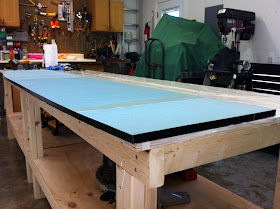Rear longeron (2.5 hrs)
The list of things to do this morning was pretty short. Number one on it was finishing the lower longeron by adding a triangular stringer.
First thing to do was removing the nails, which was accomplished in a very traditional manner, twist and pull.
Then I got sidetracked admiring the sidewall, and decided to go for a “glamour shot”. I figured it would be good for showing how all the bulkheads will eventually fit together.
After the motivational interlude, I got busy cutting and fitting the stringer, basically the other half side of the rear lower longeron.
I used plenty of wet flox on the mating surfaces, since it’s easier to clean up the excess, than it is to add more later.
Then I threw every clamp I had at it, trying to bend it to match the other half.
You might ask why I didn’t cut slots on the stringer as well, to help bend it. The answer would be, I’m not sure. But looking at everyone else’s photos of this step, no one else has found it necessary to do so, and the manual is mum on this technique as it applies to this part.
Maybe cutting on the base of the triangle might weaken it too much. Again, I’m not sure, but enough force was brought to bear that it never became an issue.
 |
| Pretty much everything I've got! |
With the flox curing I had nothing else to work on, so I went back to the lathe, and mill, made a test bushing out of some scrap, and pressed it in some leftover aluminum angle I had laying around.
 |
| This test piece has demonstrated counterboring (top hole), and now press fit steel bushing. |
The reason I am even experimenting with this, is that in CP #46 (Builder Hints), Burt states (talking about the landing gear extrusion in LMGA assembly): “ ... if you bought your extrusions from Brock, you will note that they have flanged, steel bushings pressed into the aluminum angles, these steel bushings ... are an excellent idea.”
Unfortunately he gives no dimensions at all, so I am polling all my builder friends, and trying to come up with some I can use.
UPDATE: Wade just phoned in with some dimensions he called “exact”. In reality he probably made them up to shut me up, but I’ll try them on for size next time around anyway.































